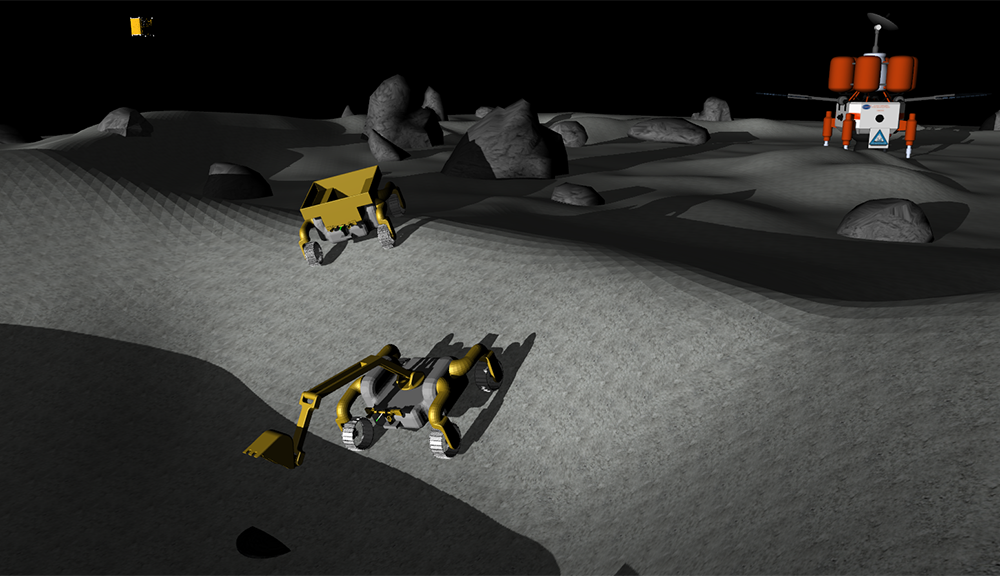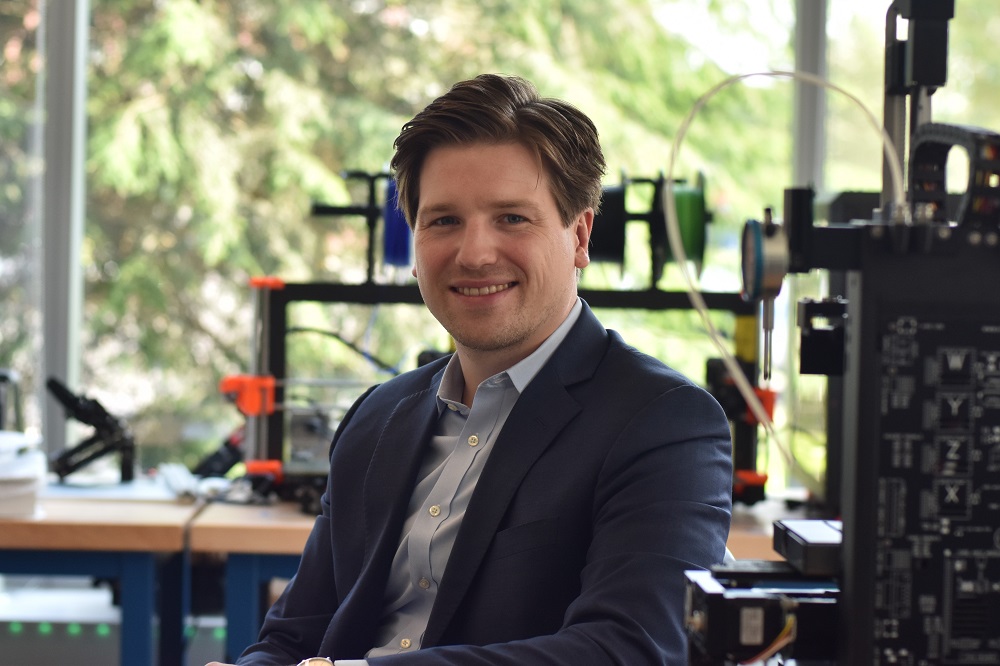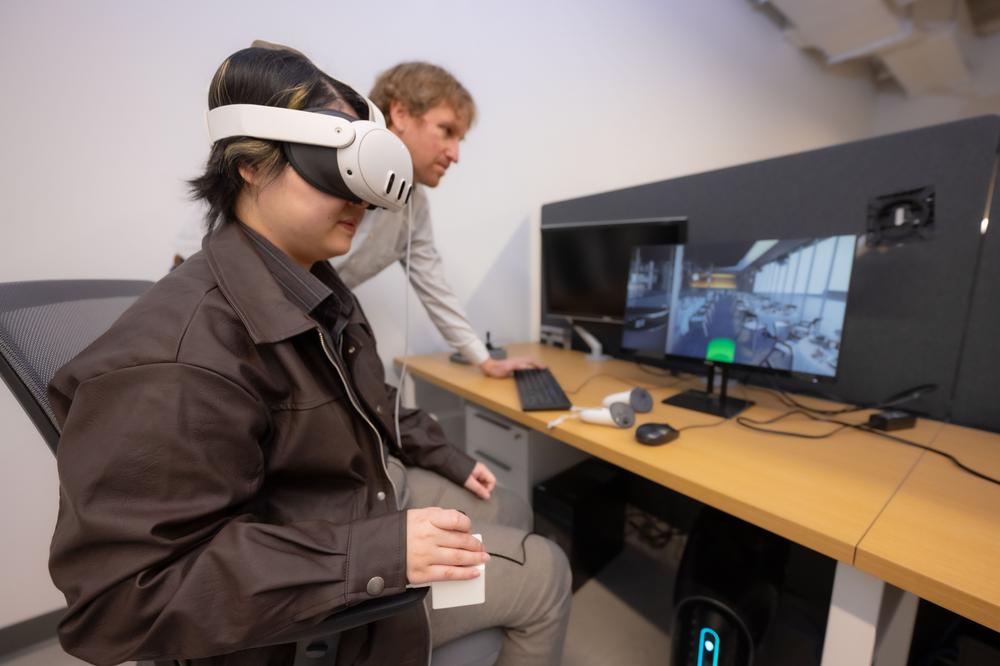A team of WPI robotics engineers led by PhD candidate R. J. Linton is among seven winners in the Virtual Robotics Challenge (VRC) sponsored by the Defense Advanced Research Projects Agency (DARPA). The competition is part of DARPA's Robotics Challenge (DRC), which aims to create a new generation of advanced humanoid robots capable of responding to natural and manmade disasters, doing jobs too hazardous for humans.
The WPI team placed second among the 26 teams that qualified for the virtual challenge, which ran from June 17-27. The VRC required teams to develop software that enables a simulated humanoid robot to autonomously complete three difficult challenges: driving a vehicle, walking across progressively more difficult terrain, and attaching a hose connector to a spigot and turning a valve.
The WPI team received no DARPA funding, but used DARPA-supplied simulation software, as did the teams that used DARPA funding. Each of the winning teams will receive a million-dollar Atlas humanoid robot developed for DARPA by Boston Dynamics, as well as funding to enable them to compete in the next phase of the DRC, in which teams will program actual humanoid robots to complete a sequence of events required to address a simulated disaster.
"This was a wonderful effort by a diverse team," said WPI Provost Eric Overström. "WPI was the first university in the nation to offer a BS program in robotics engineering, and the first to establish BS, MS, and PhD programs in this important and emerging field. It’s an honor to be given the opportunity by DARPA to compete, and to further technological advances that will benefit humankind."
"The WPI Team is thrilled to have scored so well in the DARPA Virtual Robotics Challenge," said Michael Gennert, professor of computer science and director of WPI's Robotics Engineering Program. "There were many highly qualified teams competing, and this shows that our multidisciplinary approach to robotics really works. The DARPA VRC is an important event for robotics as we develop more capable and more autonomous devices that can go where humans can't—for example, disaster sites. Now the real work begins—moving our software from simulation onto a physical robot and dealing with the complexities of the real world."
To conduct the VRC, DARPA funded the Open Source Robotics Foundation to develop a cloud-based simulator that calculates and displays the physical and sensory behaviors of robots in a three-dimensional virtual space, in real time. The simulator allowed teams to send commands and receive data over the Internet to and from a simulated Atlas robot—information very similar to what would be sent between a physical robot and its operator in the real world.
"The VRC and the DARPA Simulator allowed us to open the field for the DARPA Robotics Challenge beyond hardware to include experts in robotic software. Integrating both skill sets is vital to the long-term feasibility of robots for disaster response," said Gill Pratt, DRC program manager. "The Virtual Robotics Challenge itself was also a great technical accomplishment, as we have now tested and provided an open-source simulation platform that has the potential to catalyze the robotics and electro-mechanical systems industries by lowering costs to create low-volume, highly complex systems."
DARPA planned to award an Atlas robot and funding to the top six teams. One of those teams, from the Jet Propulsion Laboratory (JPL), chose not to accept the robot or funding as it is also the lead institution on another DRC team. In the end, DARPA awarded the JPL robot and some of its funds to the eighth-place team, from Lockheed Martin, while the seventh-place team, from Japan, and the ninth-place team, from Case Western University, merged and received the rest of JPL's funds and a robot donated by Hong Kong University. As a result, the following seven teams will advance to the next phase of the DRC:
1. Institute for Human and Machine Cognition (52 points)
2. WPI Robotics Engineering C Squad (39 points)
3. MIT (34 points)
4. TRACLabs Inc. (30 points)
5. TU Darmstadt/Virginia Tech (27 points)
6. Team K, Japan (25 points)/Case Western University (23 points)
7. Lockheed Martin (24 points)
The Robotics Challenge was created by DARPA to accelerate the development of advanced robots that can help respond to disasters like the Fukushima reactor accident in Japan. Such robots would do dangerous jobs and operate in places where people cannot safely work. They would need to work in environments and use tools made for people, drive vehicles that have not been modified, and negotiate rubble and other hazards associated with degraded environments.
The overall challenge has four tracks. Teams in tracks A and D will develop robots and operating software; teams in the A track have received up to $3 million in DARPA funding to support their work. Teams in tracks B and C competed in the VRC; the B teams were funded by DARPA, while the C teams, including WPI's, provided their own funds.
In addition to its VRC team, WPI is a member of an A team led by Paul Oh at Drexel University (other team members are from Columbia University, the University of Delaware, Georgia Tech, Indiana University, Ohio State, Purdue, Swarthmore, and the Korea Advanced Institute of Science and Technology). A and D teams, along with the seven winners of the VRC, will compete in trials this December in which their robots must complete multiple tasks, including driving and walking to reach a simulated disaster site, removing debris blocking an entrance, climbing a ladder, using power tools to breach a barrier, and locating and closing a valve. The winner of the DRC will receive $2 million.
The WPI A-team, led by Dmitry Berenson, assistant professor of computer science and robotics engineering, will develop the algorithms that will allow the team's Hubo robot to find and turn the valve. Other members of the WPI team are Sonia Chernova, assistant professor of computer science and robotics engineering, and Robert Lindeman, associate professor of computer science.
Teams in the VRC completed virtual challenges with a simulated Atlas robot. The robot and the simulated environments it operates in were located on remote servers. The competitors completed each of the three VRC challenges five times, with the details of the challenge differing for each run. For example, in one run the robot might have to climb over a pile of rubble, while in the next one it may have to cross a pit of mud in which cinderblocks have been hidden to create a tripping hazard. Each run was to be completed within 30 minutes, after which points were awarded based on how well and how quickly the task was completed and how much data the team required (since communications bandwidth may be at a premium in an actual disaster, teams can earn more points by reducing data use by, for example, minimizing the use of the camera that shows them what the robot is seeing).
To prepare for the challenge, each team received access to the simulated environments and a detailed simulation of the Atlas robot, one of the most sophisticated humanoid robots ever built. Able to walk upright and strong enough to carry heavy objects and traverse difficult terrain, the robot has 28 degrees of freedom, sensate hands for using tools, and an articulated sensor head with stereo cameras and a laser range finder.
In addition to Linton, WPI's VRC team (the WPI Robotics Engineering C Squad), consists of Oke Nnasia, graduate students in robotics engineering at WPI; Jonathan Vo, an MBA student at WPI; Perry Franklin '16, a double major in robotics engineering and computer science; WPI faculty members Taskin Padir, assistant professor of electrical and computer engineering and robotics engineering, Gregory Fischer, assistant professor of mechanical engineering, and Michael Gennert, Doug Conn and Kevin Knoedler, software professionals in California; Alison Kristoff, a software professional in Massachusetts; Mario Arbula Saavedra, a faculty member at the Universidad del La Sabana in Columbia; and Vincent Mancera Hernandez, a student at the Universidad del La Sabana.




